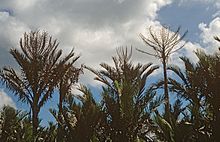bio.wikisort.org - Plant
Metroxylon sagu, the true sago palm, is a species of palm in the genus Metroxylon, native to tropical southeastern Asia, namely Indonesia (western New Guinea, and the Moluccas), Papua New Guinea, Malaysia (both Peninsular Malaysia and Sarawak) and possibly also the Philippines (though may have been introduced there).[2] It is also naturalised in Thailand, in the Indonesian islands of Java, Kalimantan, Sumatra, and in the Solomon Islands.[1]
| Sago palm | |
|---|---|
 | |
| Sago palms with characteristic terminal inflorescence/infructescence (West Seram, Maluku, Indonesia) | |
| Scientific classification | |
| Kingdom: | Plantae |
| Clade: | Tracheophytes |
| Clade: | Angiosperms |
| Clade: | Monocots |
| Clade: | Commelinids |
| Order: | Arecales |
| Family: | Arecaceae |
| Genus: | Metroxylon |
| Species: | M. sagu |
| Binomial name | |
| Metroxylon sagu | |
| Synonyms[1] | |
| |
The tree is a major source of sago starch.
Description
True sago palm is a suckering (multiple-stemmed) palm, each stem only flowering once (hapaxanthic) with a large upright terminal inflorescence. A stem grows 7–25 m tall before it ends in an inflorescence. Before flowering, a stem bears about 20 pinnate leaves up to 10 m long. Each leaf has about 150–180 leaflets up to 175 cm long. The inflorescence, 3–7.5 m tall and wide, consists of the continuation of the stem and 15–30 upwardly-curving (first-order) branches spirally arranged on it. Each first-order branch has 15–25 rigid, distichously arranged second-order branches; each second-order branch has 10–12 rigid, distichously arranged third-order branches. Flower pairs are spirally arranged on the third-order branches, each pair consisting of one male and one hermaphrodite flower. The fruit is drupe-like, about 5 cm in diameter, covered in scales which turn from bright green to straw-coloured upon ripening.[3]
Historical records
Sago was noted by the Chinese historian Zhao Rukuo (1170–1231) during the Song Dynasty. In his Zhu Fan Zhi (1225), a collection of descriptions of foreign countries, he writes that the kingdom of Boni "...produces no wheat, but hemp and rice, and they use sha-hu (sago) for grain".
Cultivation and uses
The tree is of commercial importance as the main source of sago, a starch obtained from the trunk by washing the starch kernels out of the pulverized pith with water. This starch is used in cooking for puddings, noodles, breads, and as a thickener. In the Sepik River region of New Guinea, pancakes made from sago are a staple food, often served with fresh fish. Its leaflets are also used as thatching which can remain intact for up to five years.[4] The dried petioles (called gaba-gaba in Indonesian) are used to make walls and ceilings; they are very light, and therefore also used in the construction of rafts.
The sago palm reproduces by fruiting. Each stem (trunk) in a sago palm clump flowers and fruits at the end of its life, but the sago palm as an individual organism lives on through its suckers (shoots that are continuously branching off a stem at or below ground level). To harvest the starch in the stem, it is felled shortly before or early during this final flowering stage when starch content is highest. Sago palm is propagated by man by collecting (cutting) and replanting young suckers rather than by seed.[3]
Recent research indicates that the sago palm was an important food source for the ancient people of coastal China, in the period prior to the cultivation of rice.[5]
References
- "Metroxylon sagu". World Checklist of Selected Plant Families (WCSP). Royal Botanic Gardens, Kew. Retrieved 22 Oct 2016.
- "Metroxylon sagu". Germplasm Resources Information Network (GRIN). Agricultural Research Service (ARS), United States Department of Agriculture (USDA). Retrieved 1 January 2018.
- Schuiling, D.L. (2009) Growth and development of true sago palm (Metroxylon sagu Rottbøll) with special reference to accumulation of starch in the trunk: a study on morphology, genetic variation and ecophysiology, and their implications for cultivation. (PhD thesis Wageningen University).
- Palm and Cycad Societies of Australia. Palms: Metroxylon sagu. Retrieved 28 February 2012
- "In ancient China, sago palms were major plant food prior to rice cultivation".
External links
 Media related to Metroxylon sagu at Wikimedia Commons
Media related to Metroxylon sagu at Wikimedia Commons Data related to Metroxylon sagu at Wikispecies
Data related to Metroxylon sagu at Wikispecies
На других языках
- [en] Metroxylon sagu
[ru] Саговая пальма настоящая
Саговая пальма настоящая, или Саговая пальма (лат. Metroxylon sagu), — вид пальм рода Метроксилон (Metroxylon), произрастающих в тропических лесах и на побережье островов Юго-Восточной Азии в Индонезии, на Малайском архипелаге, Фиджи и Новой Гвинеи, а также на Молуккских островах и в Малайзии. Встречается на Филиппинах, но, вероятно, туда была завезена человеком. Один из самых известных видов саговых пальм, являющихся ценными пищевыми растениями, из сердцевины ствола которых получают крахмалистый пищевой продукт саго.Другой контент может иметь иную лицензию. Перед использованием материалов сайта WikiSort.org внимательно изучите правила лицензирования конкретных элементов наполнения сайта.
WikiSort.org - проект по пересортировке и дополнению контента Википедии